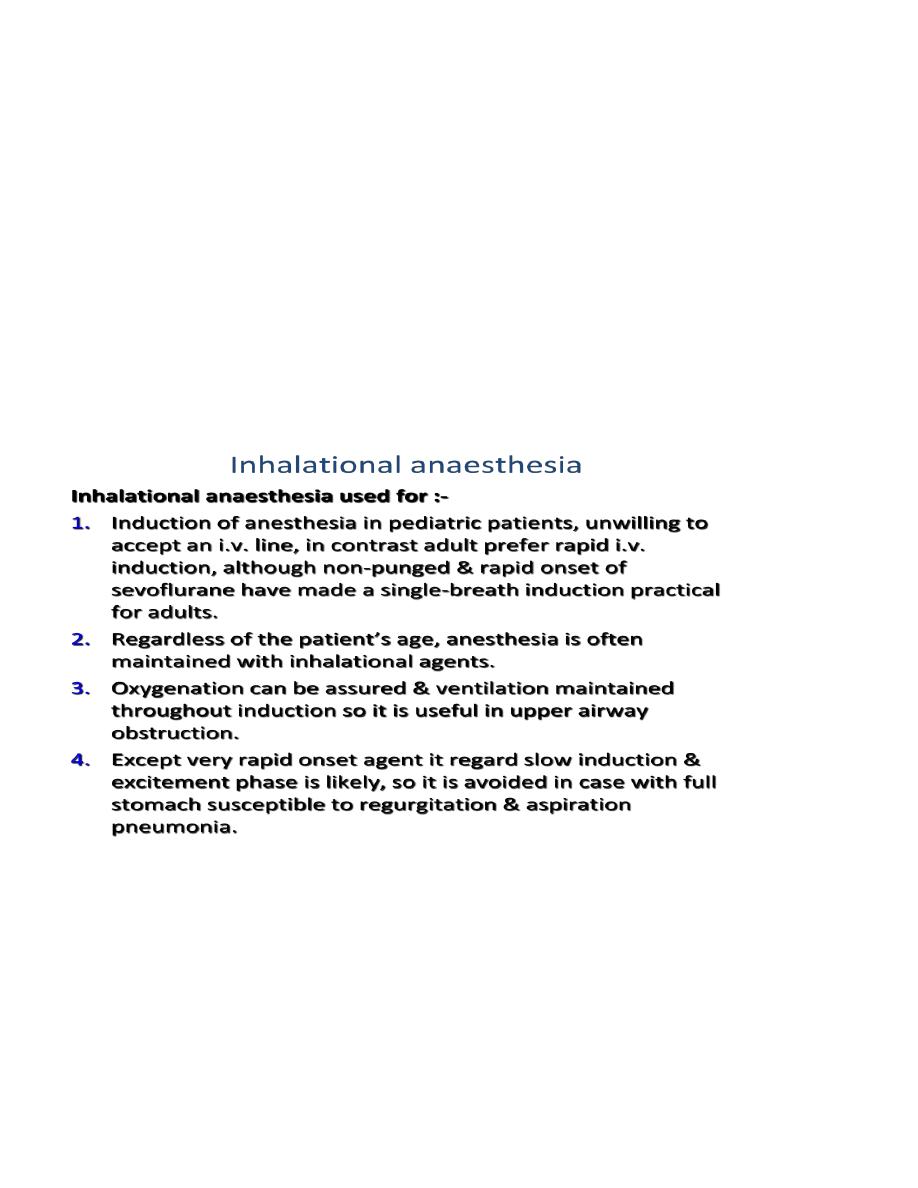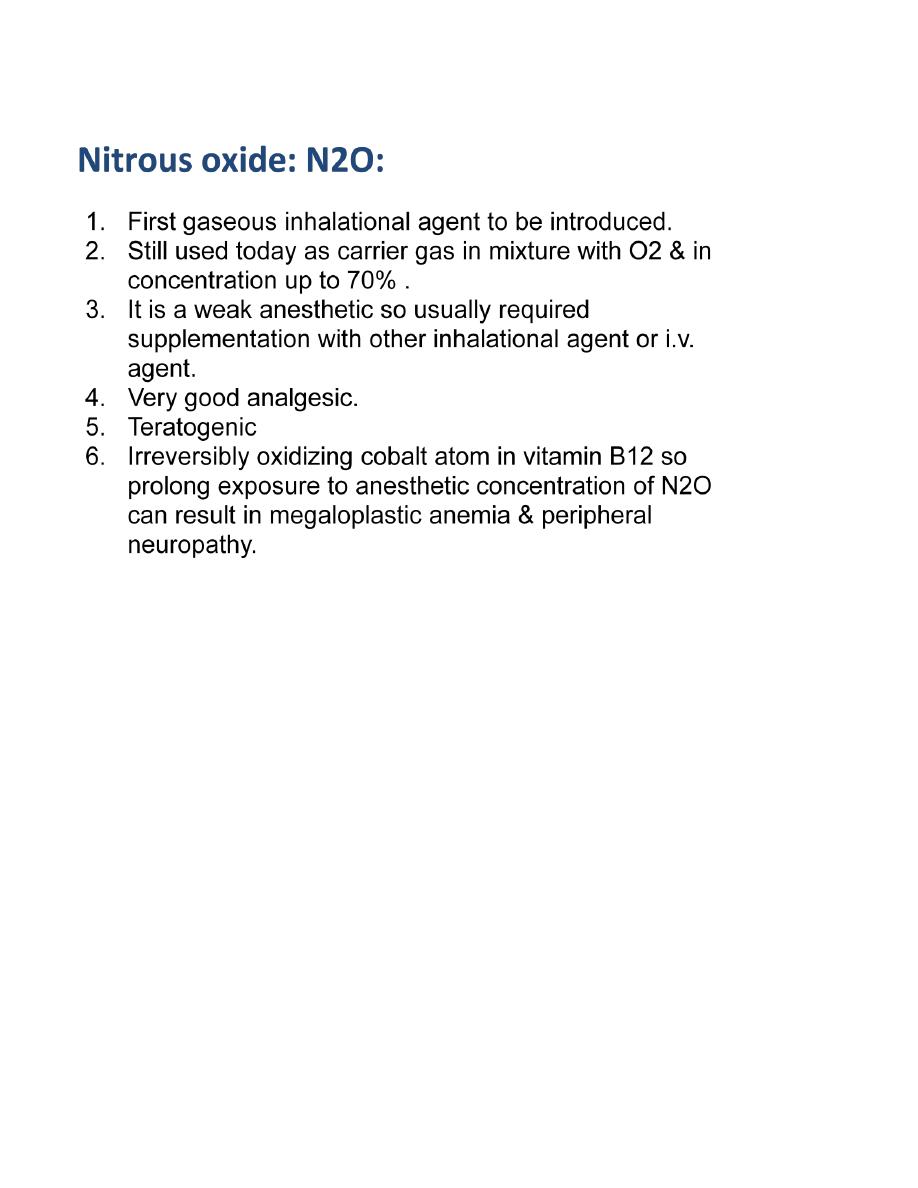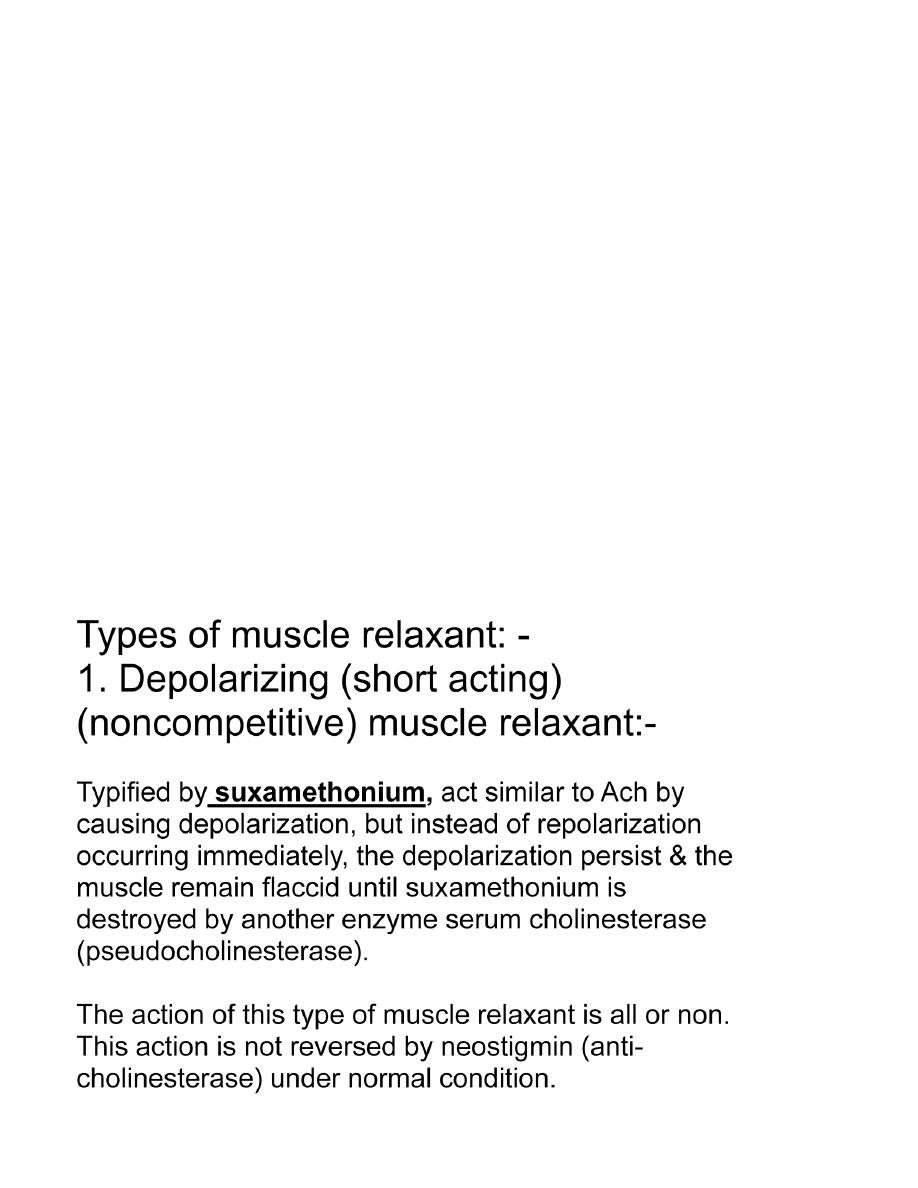
Anaesthesia
Drugs used in General Anaesthesia
Dr. Dena A. Alkazzaz
F.I.C.M.S. (Anaesthesia & intensive care)
Lecturer of anaesthesia /dep. of surgery /Mosul medical collage
Spectrum of technique available
1. Local Anaesthesia alone.
2. Local Anaesthesia with pharmalogical sedation.
3. Local Anaesthesia combined with general Anaesthesia.
4. General Anaesthesia alone, with or without paralysis by neuromuscular blocking agent
& controlled ventilation.
General Anaesthesia GA
Pharmacodynamic of GA
Drugs acting on central nervous system whatever the rout of introduction all pass into blood
stream & then transport to the brain, where they penetrate blood-brain barrier & enter
specific cell in the central nervous system, here they exert their characteristic reversible effect.
But the precise mechanism are not fully understood it probable that anaesthetic state caused
by
Alteration in the permeability of the brain cell membrane
Interference with oxygen action, intracellular hydrogen ion concentration &/or ion
exchange
Or may be distortion (reversible distortion) of the protein element of the membrane &
blocking of the sodium channels.
Depth of anesthesia (Guedel Classification):
Described for spontaneous respiration with diethyl ether in 1937.
Stage 1: Analgesia: begin with the beginning of induction & end at loss of consciousness. This
stage characterize by: -
1. Regular, small volume respiration.
2. Pupil’s normal.

Stage 2: Excitement: start from the loss of consciousness tells the automatic breathing
started. . This stage characterize by: -
1. Irregular respiration.
2. Divergent, dilated, pupils.
3. Active laryngeal & pharyngeal reflexes.
4. Eyelash reflex abolished.
Stage 3: Surgical anaesthesia: start by automatic respiration to respiratory paralysis. Divided
into
Plane 1:
1. Regular large volume respiration.
2. Central pinpoint pupils.
3. Cessation eye movement.Eyelid reflex abolished.
Plane 2:
1. Thoracic component of respiration decreased.
2. Loss of corneal reflex.
Plane 3:
1. Respiration becomes diaphragmatic, small volume.
2. Laryngeal reflex depressed.
3. Pupils normal.
Plane 4:
1. Irregular diaphragmatic, small volume respiration.
2. Dilated pupils.
3. Carinal reflex depressed.
Stage 4: Coma: characterize by apnoea, hypotension.

Intravenous anesthesia
I.V. anesthetic agents may be used for: -
1. The induction of anesthesia.
2. As the sole agent for total intravenous anaesthesia (TIVA).
3. To supplement volatile anesthesia or regional anesthesia.
4. Sedation.
I.V. induction characterize by: -
1. Rapid & pleasant for the patient.
2. The excitement stage & atmospheric pollution that are almost inevitable with
inhalational induction are avoided.
3. It is relatively easy to overdose the patient.
4. Not easy to withdraw the drug.
Drugs used for intravenous anesthesia: -
1. Barbiturates: -e.g.Thiopental,Methohexital.
2. Ketamine
3. Etomidate
4. Propofol
5. Benzodiazepines
6. Opioids
Thiopental: -
1.The most commonly used i.v. anesthetic, it is hypnotic & anticonvulsant.
2. Rapid onset (30 sec).
3. Short duration of action 6-8 min. ( patient awake within 20 min.).
4. Given i.v. for induction of anesthesia in adult & children, with i.v. line.
5. Given rectally for induction of anesthesia in children.

6. Cardiovascular effect: -decrease BP, increase heart rate
7. Respiratory effect: -central respiratory depression, cause apnea, cause upper airway
obstruction, Bronchospasm in asthmatic patient, laryngospasm when instrumented
upper airway under light anesthesia.
8. Central nervous system: - decrease cerebral blood flow & more decrease intracranial
pressure so lead to increase cerebral perfusion pressure, decrease cerebral oxygen
consumption by 50% of normal, this give brain protection again focal ischemia. Small
dose can control most grand mal seizure.
9. Metabolically: -can precipitate acute intermittent porphyria in susceptible patient.
10. Immunologically: - can cause histamine release.
Ketamine: -
1. Cause dissociative anesthesia; - that the patient appears conscious (e.g. eye opening,
swallowing, muscle contracture) but unable to process or respond to sensory input.
2. Use as i.v. & i.m. anesthetic agent.
3. Psychotomimetic effect can cause hallucination. But it is less common in children & in
patient premedicated with benzodiazepines.
4. Onset of anesthesia is slower than that of thiopental.
5. Duration of action longer than thiopental, its(10-15 min)
6. Muscle twitching & rigidity occur initially.
7. Cardiovascular stimulant (BP well maintained in poor risk patient e.g. shock state).
8. Bronchodilator, so used in asthmatic patient.
Etomidate: -
1. Onset is rapid.
2. There is pain at injection site.
3. Muscle movement is common at induction of anesthesia.
4. It is least likely of commonly used agent to upset the cardiovascular state or release of
histamine.

5. It may depress the cortisol production especially if given by infusion.
Propofol: -
1. Onset within 30 sec.
2. Duration of action 4-5 min.
3. Cause some pain on injection but not irritant to the vein.
4. It is now the drug of choice for out patient surgery.
5. Cause hypotension due to vasodilatation.
6. Bronchial muscle tone not changes.
Benzodiazepines: -
1. Used for sedation or induction of general anesthesia.
2. For sedation diazepam & lorazepam well absorbed orally that peak effect reached within 1-
2h, i.m. injection of diazepam is painful & unreliable, while lorazepam & midazolam are well
absorbed after i.m. injection that peak effect reached within 1-1.5h.
3. For induction of anesthesia large doses are required
4. Onset slower than other i.v. induction agent.
5. Used in poor risk patient that it has minimal cardiovascular effect, little decrease in BP,
peripheral vascular resistance & cardiac output while heart rate sometime rises.
6. I.v. administration cause depression of respiratory response to CO2 & may cause respiratory
arrest. So titrate i.v. dose (used for sedation) to avoid apnea with respiratory monitoring &
availability of resuscitation equipment.
7. Decrease cerebral blood flow, decrease intracranial pressure & decrease cerebral oxygen
consumption. Prevent & control grand mal seizure.
8. Oral sedative doses produce antegrade amnesia.
9. Has no direct analgesic property.

Opioids: -
1. Used for premedication, induction of general anesthesia, maintenance of general anesthesia
& postoperative analgesia.
2. Cause respiratory depression.
3. Do not seriously impaired cardiovascular function.
4. Slow gastric emptying time.
5. Decrease cerebral blood flow, decrease intracranial pressure & decrease cerebral oxygen
consumption, when maintain normocarbia by artificial ventilation
Inhalational anaesthesia
Drugs used for inhalational anaesthesia
Nitrous oxide: N2O
Ether (diethyl ether)
Halothane (fluothane)

Nitrous oxide: N2O:
6. N2O is 35 time more soluble than N2 in the blood, thus it tend to diffuse into air-containing
cavities more rapidly than N2 be absorbed by blood stream so cause expanding air-containing
cavity or may cause increase pressure inside the cavity e.g.: -
1) Air embolism.
2) Pneumothorax.
3) Acute intestinal obstruction.
4) Intracranial air (tension pneumocephalous) following dural closure or
pneumoencephalography.
5) Pulmonary air cyst.
6) Intraocular air bubbles.
7) Tympanic membrane grafting.

Ether (diethyl ether): -
1. First volatile agent is rarely used now.
2. It is flammable, pungent smell.
3. It is irritant.
4. It is safe but unpleasant agent for inhalation induction.
5. Cumulative effect lead to prolong post-operative drowsiness.
6. Few cardiac irregularity, BP &cardiac output are maintained.
7. Bronchodilator
Halothane (fluothane): -
1. Non flammable, non irritant
2. Potent, rapid induction & rapid recovery.
3. Respiratory depressant but cause bronchodilation.
4. Cause cardiac depression, decrease cardiac output by decrease heart rate & decrease
contractility& decrease BP.
5. Sensitize the heart to the dysrhythmogenic effect of epinephrine, so that doses of
epinephrine >1.5 microg/kg should be avoided.
6. Increase cerebral blood flow &decrease metabolic O2 requirement, increase
intracranial pressure, which can prevented by establishing hyperventilation before
halothane administration.
7. It cause relaxation of pregnant uterus in concentration >0.5 %
8. It is poor analgesic.
9. 20% of halothane metabolized in the liver, it is reductive form can cause halothane
hepatitis which is extremely rare 1/35000.

Guidelines for halothane exposure:
Avoid halothane if previous exposure within 3 months.
Avoided in previous adverse reaction to halothane.
Avoided in family history of adverse reaction to halothane.
Isoflurane:-
1. Respiratory depressant like halothane.
2. It has less cardiac depressant effect & does not precipitate dysrhythmia but produce
hypotension by vasodilatation & may cause coronary steel syndrome.
3. Only 0.2 % metabolized & consequently has no significant renal or hepatic toxicity.
Sevoflurane:-
1. Cardiovascular effect similar to isoflurane but less tachycardia & coroanary
vasodilatation (no evidence to coronary steel).
2. Does not precipitate dysrhythmia.
3. Respiratory depressant like halothane.
4. Not irritant to upper respiratory tract.
5. Faster induction & elimination than halothane.
6. 2% are metabolized, no renal or hepatic toxicity are reported.
7. Decomposed by sodalime (which is used in closed circuit to absorb CO2 from expired
gas).
Desflurane:-
1. Cardiac effect similar to isoflurane.
2. Does not precipitate dysrhythmia.
3. Respiratory depressant like halothane.
4. Irritant to upper respiratory tract, so not suitable to gas induction.
5. Faster gas induction & elimination than halothane.

6. Only 0.02% metabolized.
Neuromuscular blocking agent
(Muscle relaxant)
Transmission of nerve impulse to the muscle at the neuromuscular junction (NMJ) of
voluntary muscle is accomplished by Acetylcholine (Ach). That large amount of Ach are
released when an impulse is conducted down the motor nerve fiber to the nerve ending,
Ach cross myoneural junctional cleft & become attached to the paired lipoprotein
receptors grouped around ion channels in the membrane. This makes the membrane of the
motor end plate permeable to an inward flow of sodium ion & calcium ion & the exit of
intracellular potassium ion. Depolarization thus occurs, an electrical potential is produced
& propagated lead to muscle contraction
The Ach is then rapidly hydrolyzed by acetyl cholinesterase, which is present in the
vicinity of the motor end plate. The products are then taken up again by the nerve ending
and resynthesized into Ach & neuromuscular junction repolarized & awaits the next
impulse.

2. Non-depolarizing (competitive) muscle relaxant:
These are typified by tubocurarine, which accompany end-plate without causing
depolarization, & thus deny all or some of the receptors to the natural transmitter Ach. The
overall effect of non-depolarizing (competitive) muscle relaxant will, therefore, depend on
how many receptors are occupied, weakened rather than paralyzed muscle will result if some
Ach molecule still manage to occupy some receptors. Neuromuscular block is reversed by
neostigmin by inhibition of acetylcholinesterase so the local concentration of Ach increase,
which then compete for the receptors & reverse the neuromuscular block. The non-
depolarizing agent is then removed in the blood stream & excreted or destroyed; normal
neuromuscular transmission is thus restored.
Indication to use of muscle relaxant:-
1. Facilitate tracheal intubations by relaxing the jaw & laryngopharyngeal muscles.
2. Continued muscle relaxation during surgery to facilitate artificial ventilation (IPPV:
intermittent positive pressure ventilation).
Choice of muscle relaxant depends on: -
1. Duration of action required.
2. Consideration hemodynamic effect.
3. Rout of metabolism & excretion.
4. Reversion of non-depolarizing (competitive) muscle relaxant: -
5.
At the end of surgery it is essential to restore the action of the muscle of
respiration (diaphragm & intercostals muscles) to ensure that the respiration is
adequate before the patient is sent to the recovery room, so anticholinesterase such as
Neostigmin is usually required. This drug has dangerous autonomic side effect on
(muscarinic receptors) causing bradycardia, excessive bronchial & salivary secretion, so
vagolytic drugs such as Atropine must add to Neostigmin.
Sxamethonium (Scolin): -
1. Only depolarizing muscle relaxant in use.
2. Has rapid onset 15-45 sec.
3. Duration of action 3-10 min.

4. Rapidly destroyed by plasma cholinesterase
5. It is used for tracheal intubation.
6. Depolarization cause muscle fibrillation (fasciculation), which lead to post operative
muscle pain.
7. Cause bradycardia especially after second dose.
8. Increase serum level of potassium & sever increase occur in patient with burn, or
massive trauma, or presence of upper or lower motor neuron lesion.
9. May cause scolin apnea in patient with atypical or absent pseudocholinesterase enzyme
of a hereditary nature.
10. Can precipitate malignant hyperthermia
